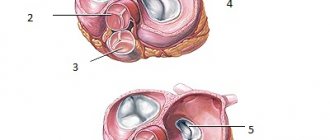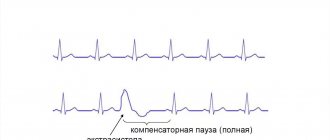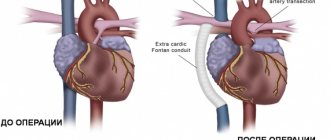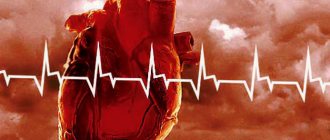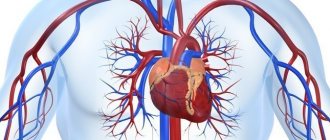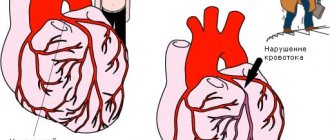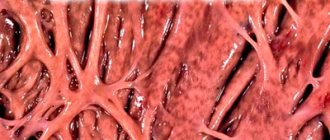Cardiac rupture is a violation of the integrity of one or another section of the myocardium, leading to massive bleeding and significant disruption of hemodynamics. The appearance of this condition requires emergency cardiac surgery and intensive care, but in many cases it quickly leads to death.
Many people not involved in medicine believe that heart rupture can only occur due to severe fright or stress. Due to the prevailing stereotype, many of us do not know that damage to the integrity of this vital organ can be caused by a variety of diseases or conditions, and it is possible to protect ourselves from such a dangerous complication if we do not forget about the timely prevention or treatment of pathologies of the heart and blood vessels.
The heart is the main component of the circulatory system, and without it, normal blood flow becomes impossible. Most often, rupture of its walls is provoked by complications of myocardial infarction and occurs in approximately 8% of patients. According to the observation of many cardiologists, such a consequence of this serious disease is caused not by a repeated, but by the first episode of a heart attack and most often occurs in the first 5-7 days. In addition, other diseases and conditions may be predisposing factors to the onset of cardiac rupture.
In this article, we will introduce you to the main causes, types, symptoms, methods of emergency cardiac surgery and intensive care for heart rupture and the prevention of this extremely dangerous complication. This information will help you recognize the alarming symptoms of this life-threatening condition in time and give you the answer to the question: “Can the patient be saved?”
Causes
In some cases, myocardial infarction leads to heart rupture.
Rupture of the walls of the heart can be caused by the following diseases and conditions:
- myocardial infarction;
- heart injuries;
- endocarditis;
- congenital heart defects
- tumors;
- metabolic disorders leading to infiltration of heart tissue (sarcoidosis, hemochromatosis, amyloidosis).
The main cause of rupture is structural changes in the myocardium. Normally, its tissue is quite elastic and dense and therefore cannot tear. Most often, damage to the integrity of the myocardium is caused by a heart attack, accompanied by necrosis of cardiac muscle tissue.
Typically, with myocardial infarction, rupture of the left ventricle occurs, because It is this cardiac chamber that is subject to the greatest loads and muscle necrosis most often occurs in this part of the heart. In almost 3% of cases, a violation of the integrity of the heart muscle occurs in the area of the interventricular septum, and the precursor to such a rupture is an extensive infarction, covering a significant amount of tissue. Ruptures in the right chambers or atria of the heart are extremely rare.
Other common causes of cardiac rupture include endocarditis, tumor formations and metabolic disorders. With these diseases, the structure of the heart muscle changes, it becomes less elastic, durable and can rupture under significant stress.
In addition, trauma becomes a relatively common cause of myocardial rupture. This could be the consequences of an accident, gunshot or knife wounds, strong blows during sports or falls.
The common belief that heart rupture can be caused by fear or severe stress may also be valid. In some cases, after autopsies of people who have survived these conditions, the cause of death is revealed as tamponade of the heart with blood, causing it to stop. However, more often death after severe emotional shock occurs due to myocardial infarction caused by excessive stress.
In addition to the causes of heart rupture, cardiologists also identify a number of factors predisposing to its occurrence:
- arterial hypertension;
- untimely provision of assistance to a patient with myocardial infarction;
- late administration of thrombolytics (drugs for dissolving blood clots) during myocardial infarction;
- untimely start of activity or excessive load on the patient after a heart attack;
- age after 50 years, when the heart muscle begins to suffer from ischemia and tissue healing processes slow down;
- exhaustion of the patient, leading to longer healing of the scar in the area of the infarction;
- taking hormonal or non-steroidal anti-inflammatory drugs that slow down scar healing.
Possible complications
The main complications are as follows:
- If a person has a rupture of the heart muscle, then without proper medical care he dies. To prevent this from happening, he needs urgent surgery. If the gap is small, then a person can live only two months without surgery.
- The forecasts, unfortunately, are disappointing, because almost half of the patients may die, even if the operation was performed on time and with proper quality. The thing is that the sutures placed during suturing often come apart.
If you start treatment in a timely manner, it is possible to eliminate complications.
Types of heart ruptures
Depending on the location of the myocardial rupture, the following types of damage are distinguished:
- external rupture – there is a through violation of the integrity of the heart wall, leading to the outflow and accumulation of blood in the pericardial sac (hemopericardium);
- internal rupture – there is a violation of the integrity of the internal structures of the heart (for example, rupture of the interventricular septum or papillary muscles).
With external ruptures, the blood in the heart, under high pressure, immediately enters the pericardial sac limited by the pericardium. After it fills, which happens very quickly, the heart loses its ability to contract due to tamponade and stops. In all organs, a deficiency of blood flow occurs and shock develops, leading to death.
Manifestations of internal cardiac rupture may be less pronounced, but all of them are indications for immediate cardiac surgery, because may cause death. Damage to the papillary muscles, chords or rupture of the interventricular septum leads to significant disruption of hemodynamics and mixing of blood from different parts of the heart. In some cases, a patient in this condition can live for about 2 weeks or months, but subsequently, without surgical intervention, he will progress to acute heart failure, causing death.
Heart ruptures can also be classified according to the timing of their occurrence:
- early rupture - occurs on the 1st or 3rd day from the moment of injury or heart attack;
- late rupture - occurs at a later date due to insufficient healing of the post-infarction scar and its damage caused by excessive physical activity.
In some cases, with the development of extensive myocardial infarction, a simultaneous rupture . With this development of events, death occurs suddenly. If the depth of the rupture does not extend to the entire thickness of the heart muscle, and its area is relatively small, then immediate death does not occur. In such patients, blood circulation deteriorates with progression, the condition worsens, and without immediate assistance, death occurs. Such a gap is called slow-flowing .
Symptoms
Symptoms of cardiac rupture include sudden pain in the heart, which is soon followed by a drop in blood pressure.
The severity of cardiac rupture manifestations depends on several parameters:
- area of myocardial damage;
- presence or absence of hemopericardium;
- severity of hemodynamic disturbances.
The appearance of a heart rupture may be preceded by some warning symptoms. Usually, at first the patient develops pain in the heart, which is not relieved by taking Nitroglycerin or narcotic analgesics. Subsequently, his blood pressure drops sharply, his pulse is hard to palpate and becomes thread-like, pallor appears, followed by cyanosis, and consciousness becomes depressed.
Internal or small tears without significant hemopericardium
With a small defect in the outer walls of the heart or internal ruptures, signs of this condition can increase over tens of minutes or several hours. The patient experiences the following complaints and symptoms:
- intense and sharp pain behind the sternum or in the heart;
- severe anxiety (up to psychomotor agitation);
- cold sweat;
- dyspnea;
- cyanosis of the skin;
- swelling.
All these signs indicate acute heart failure. They progress, and the patient’s blood pressure decreases, the pulse becomes weak and thready, and consciousness begins to disturb (even to the point of fainting). Attempts to eliminate pain with nitrate-containing or narcotic drugs remain unsuccessful, and without immediate assistance, the patient’s condition constantly worsens. The developing stagnation of venous blood leads to an increase in liver volume and the appearance of pain in the right hypochondrium. The patient's swelling increases.
Some internal heart ruptures can be just as dangerous as external ones. If there is a significant violation of the integrity of the interventricular septum, the patient develops increasing signs of cardiogenic shock, and it is almost impossible to save his life in such situations. And when the papillary muscles of the left ventricle are ruptured, the movement of blood in this half of the heart is so disrupted that it becomes the cause of the development of pulmonary edema.
External ruptures with hemopericardium
With such violations of the integrity of the myocardium, the symptoms that arise indicate the accumulation of blood in the pericardial sac and difficulty in the functioning of the heart. The patient has:
- loss of consciousness;
- severe shortness of breath, leading to complete cessation of breathing;
- swelling of the neck veins;
- increasing swelling;
- thready and weak pulse;
- a sharp decrease in pressure, followed by a state of shock up to a complete absence of pressure.
The above-described symptoms of hemotamponade and cardiogenic shock increase within a few minutes, and in the absence of immediate help, which is not always possible, the patient dies. In approximately 90% of cases, external myocardial ruptures occur suddenly and are often fatal.
Diagnostics
Diagnostic methods for this pathology are as follows:
- Studying the medical history - when the pain occurred, general malaise, what caused the appearance of symptoms, the presence of traumatic injuries to the chest, and much more.
- The patient's lifestyle is studied - what diseases the person suffered in the past, what his relatives suffer from (we are talking about heart diseases). Presence of genetic diseases in the family. Use of any medications by the patient.
- Visual inspection. The doctor examines the shade of the skin, the occurrence of edema, and measures pulse and blood pressure. Listens to the heartbeat.
- Laboratory tests of urine and blood are prescribed.
- The patient's blood coagulability is determined.
- Electrocardiography. With this pathology, the results of the ECG remain normal, but after some time the indicators worsen. It should be noted that this diagnostic method is ineffective.
- Echocardiography, so-called ultrasound of the heart muscle. During this study, it is possible to determine the area of the lesion, its size, and the volume of blood in the heart sac. In addition, this diagnostic method determines the strength of heart contraction, and if it is too reduced, then the prognosis of the disease is unfavorable.
- A catheter is inserted into the right side of the heart muscle to determine the amount of oxygen. Its amount should be the same in the atrium and ventricle. If there is a break in the heart line, then the oxygen level in the ventricle is much increased compared to the right atrium.
Transesophageal echocardiography
Based on the diagnostic results, therapeutic measures will be determined.
Treatment
Treatment for heart ruptures always involves emergency cardiac surgery and intensive care. Due to the suddenness of the development of this condition, it is not in all cases possible to provide the patient with the necessary assistance, because Violations of the integrity of the myocardium occur suddenly, develop rapidly and can lead to death within a few minutes. In such situations, the patient is not always in the cardiac surgery hospital, and there is not enough time for preoperative preparation and transportation to the operating room.
Preoperative period
A patient with suspected heart rupture requires urgent surgery and intensive care.
This stage of treatment for cardiac rupture should be very short, because... Providing surgical care should always be an emergency. Sometimes it is carried out already in the operating room.
The following steps can be taken to prepare for surgery:
- Intra-aortic balloon counterpulsation. This event involves the immediate implantation of a mechanical device into the thoracic aorta to maintain the pumping function of the heart. The intra-aortic balloon, made of polyurethane, is periodically inflated in accordance with the phases of contraction and relaxation of the heart. These measures reduce the load on the myocardium and somewhat stabilize the blood supply to other organs (including the heart itself).
- Pericardiocentesis. This manipulation involves puncture of the pericardial sac and removal of accumulated blood to the outside. Such measures can reduce compression of the heart.
- Intravenous infusion of nitrate-containing drugs. These drugs reduce vascular resistance and reduce myocardial oxygen demand.
Cardiac surgery
The type of cardiac surgery for heart ruptures is determined by the type of damage or the technical capabilities of the medical institution.
To eliminate myocardial damage, the following operations can be performed:
- open heart surgery - the rupture is sutured with special pads or a “patch” of synthetic material is applied to the damaged area;
- intravascular (or endovascular) surgery on a closed heart - applying a “patch” to the damaged interventricular septum is performed through the lumen of the vessels and under the control of X-ray equipment;
- removal of a left ventricular aneurysm - is performed if there is a protrusion in this part of the heart and is always supplemented by applying a “patch”;
- mitral valve implantation – performed when this valve is damaged or its papillary muscles are ruptured;
- coronary artery bypass grafting – used when it is necessary to create bypass blood supply routes and is supplemented by the application of a “patch”;
- amputation of the apex of the heart - performed for ruptures in this part of the heart and combined with excision of the damaged area;
- Donor heart transplantation is carried out only if a suitable donor organ is available.
Unfortunately, even with timely cardiac surgery, death occurs in almost half of the patients. This is explained by the fact that the sutures performed during the operation are prone to self-cutting even before the damaged myocardium has completely healed.
Prevention
Prevention of heart ruptures comes down to timely detection and treatment of heart and vascular diseases and proper provision of care to patients with myocardial infarction. To prevent such heart damage, the following rules should be followed:
- Monitor your cholesterol levels and follow all doctor’s recommendations to eliminate hypercholesterolemia.
- Regularly measure blood pressure and maintain it within normal limits (from 90/60 to 140/90 mm Hg).
- To refuse from bad habits.
- Eat properly.
- Seek medical help if you experience heart pain lasting more than 5 minutes.
- If you are diagnosed with coronary heart disease, regularly visit your doctor and follow all his recommendations about clinical observation, treatment and prevention.
- Immediately call an ambulance if you suspect a myocardial infarction and properly provide first aid to the patient.
- Carefully transport patients with or suspected of myocardial infarction to a medical facility.
- Strictly follow all doctor’s recommendations after myocardial infarction regarding motor activity.
- To prevent the occurrence of conditions (heavy lifting, coughing, vomiting, straining with constipation) that cause an increase in pressure in the cardiac ventricles among people at increased risk of heart rupture.
Heart rupture is a severe complication of cardiovascular diseases or injuries and requires immediate cardiac surgery. In many cases, this condition leads to the death of the patient even at the prehospital stage. In addition, even timely surgery does not always save the patient’s life, and in approximately 50% of such patients death occurs due to self-cutting sutures.
Who is at risk of myocardial infarction
Risk factors are:
- hypertonic disease;
- previous heart attack;
- smoking;
- sedentary lifestyle;
- hereditary predisposition;
- increased levels of “bad” cholesterol in the blood;
- obesity;
- diabetes;
- elderly age;
- postmenopausal state (in women);
- regular stress;
- excessive stress (physical and emotional);
- bleeding disorders.
